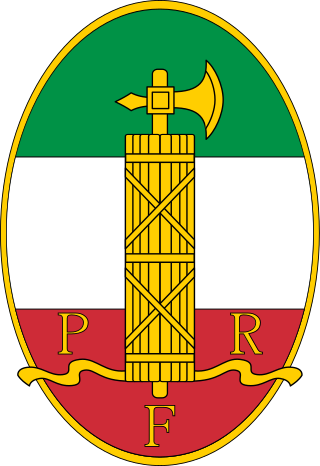Republican Fascist Party
Italian fascist political party From Wikipedia, the free encyclopedia
The Republican Fascist Party (Italian: Partito Fascista Repubblicano, PFR) was a political party in Italy led by Benito Mussolini and the sole representative party of the Italian Social Republic during the German occupation of Italy. The PFR was the successor to the National Fascist Party but was more influenced by pre-1922 early radical fascism and anti-monarchism, as its members considered King Victor Emmanuel III to be a traitor after his agreement of the signing of the surrender to the Allies.
Republican Fascist Party Partito Fascista Repubblicano | |
|---|---|
 | |
| Abbreviation | PFR |
| Duce | Benito Mussolini |
| Secretary | Alessandro Pavolini |
| Founded | 13 September 1943 |
| Dissolved | 2 May 1945[a] |
| Preceded by | National Fascist Party |
| Succeeded by | Italian Social Movement (de facto) |
| Headquarters | Palazzo Castani, Milan |
| Newspaper | Il Lavoro Fascista |
| Paramilitary wing | Black Brigades (from 1944) |
| Membership | 900,000 (1943 est.) |
| Ideology | Fascism Republicanism Sansepolcrismo Anti-monarchism Pro-Nazism[6] |
| Political position | Far-right[9] |
| Colours | Black[10] |
| Anthem | "Giovinezza"[11] |
History
Summarize
Perspective

After the Nazi-engineered Gran Sasso raid liberated Mussolini, the National Fascist Party (PNF) was revived on 13 September 1943 as the Republican Fascist Party (PFR) and as the single party of the Northern and Nazi-protected Italian Social Republic, informally known as the Salò Republic. Its secretary was Alessandro Pavolini.
Due to the strong control of the Germans, the party's power in the context of the Republic of Salò was always very limited. To obviate this inherent weakness, the party tried to obtain the support of the few population strata who still sympathised with fascism.[12] In the provinces under the control of the Germans it was organised into three entities called Administrative, Assistance, and Political.[13] The Assistance, also called the National Fascist Assistance Body, was formed in early October 1943. In the minds of the party leaders, the Assistance was to be a continuation of the powerful cadres of militants and volunteers of the former National Fascist Party.[13]
The PFR did not outlast Mussolini's execution and the disappearance of the Salò state in April 1945. However, it inspired the creation of the Italian Social Movement (MSI)[14] and the MSI has been seen as the successor to the PFR and the PNF.[15] The MSI was formed by former Fascist leaders and veterans of the National Republican Army of the Salò Republic.[16] The party tried to modernise and revise fascist doctrine into a more moderate and sophisticated direction.[17]
Giuseppe Pizzirani led the PFR organisation in Rome until April 1944, when he was named Deputy Secretary of the national party organisation.[18]
Ideology
Summarize
Perspective
The PFR sought to reconnect the new party with pre-1922 radical fascism. This move attracted parts of the fascist 'Old Guard', who had been sidelined after Mussolini had come to power in 1922. The new party was, however, internally divided, with different internal tendencies vying for Mussolini's support, and whilst the PFR revived some of the early revolutionary fascist discourse, it did not return to the anti-clerical positions of the early fascist movement.[19]
In addition, the party promoted a revolutionary[20][21] form of Italian nationalism,[22][23][24][25] antisemitism,[26][27] anti-liberalism,[28][29] anti-communism,[30] anti-capitalism,[31] anti-monarchism, and republicanism. The RSI program, set out in the "Verona Manifesto" and approved by the congress of the Republican Fascist Party (Verona 15-16 November 1943), revived the revolutionary formulas of early fascism and included, among other things, the abandonment of corporatism and the creation of a National Confederation of Labour, a broad program of social welfare and worker participation in company profits.[32] The program, opposed by the Germans and by Italian industrialists, was not implemented while, starting with the strikes of March 1944, a growing workers' opposition to the RSI developed.
Secretary of the PFR
- Alessandro Pavolini (15 November 1943 – 28 April 1945)
National Congress
- 1st National Congress – Verona, 14–15 November 1943
References
Wikiwand - on
Seamless Wikipedia browsing. On steroids.
